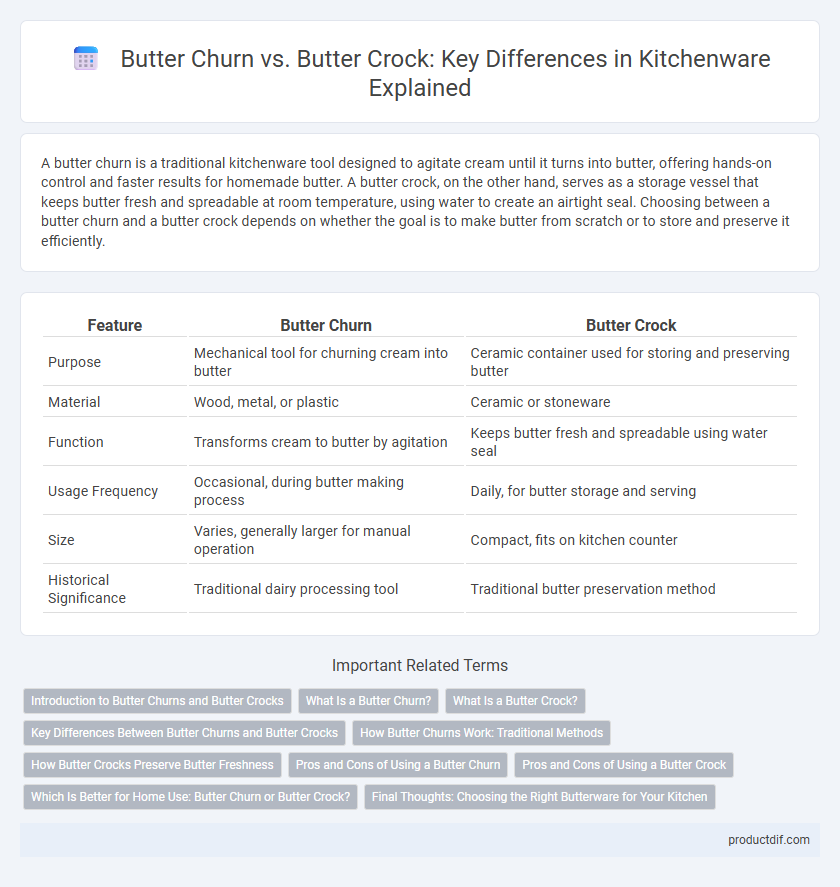A butter churn is a traditional kitchenware tool designed to agitate cream until it turns into butter, offering hands-on control and faster results for homemade butter. A butter crock, on the other hand, serves as a storage vessel that keeps butter fresh and spreadable at room temperature, using water to create an airtight seal. Choosing between a butter churn and a butter crock depends on whether the goal is to make butter from scratch or to store and preserve it efficiently.
Table of Comparison
| Feature | Butter Churn | Butter Crock |
|---|---|---|
| Purpose | Mechanical tool for churning cream into butter | Ceramic container used for storing and preserving butter |
| Material | Wood, metal, or plastic | Ceramic or stoneware |
| Function | Transforms cream to butter by agitation | Keeps butter fresh and spreadable using water seal |
| Usage Frequency | Occasional, during butter making process | Daily, for butter storage and serving |
| Size | Varies, generally larger for manual operation | Compact, fits on kitchen counter |
| Historical Significance | Traditional dairy processing tool | Traditional butter preservation method |
Introduction to Butter Churns and Butter Crocks
Butter churns are traditional kitchen tools designed to agitate cream until it separates into butter and buttermilk, typically featuring a hand-crank or plunge mechanism for efficient churning. Butter crocks serve as storage containers that promote slow fermentation and preservation of freshly made butter, often crafted from ceramic materials to maintain ideal temperature and moisture levels. Understanding these kitchenware essentials highlights their distinct roles in homemade butter production and storage, reflecting both historical and practical culinary applications.
What Is a Butter Churn?
A butter churn is a traditional kitchen tool designed to convert cream into butter through a manual or electric churning process, typically consisting of a tall container with a plunger or paddle. Unlike a butter crock, which is used for storing and culturing butter, a butter churn actively agitates the cream to separate butterfat from buttermilk. This tool is essential for artisanal butter-making, offering control over texture and freshness.
What Is a Butter Crock?
A butter crock is a ceramic container designed to keep butter fresh and spreadable without refrigeration by creating an airtight seal with water in the lid's moat. Unlike a butter churn, which is used to make butter by agitating cream, a butter crock preserves and stores butter at room temperature. Its traditional design helps maintain the butter's texture and flavor while preventing spoilage.
Key Differences Between Butter Churns and Butter Crocks
Butter churns are mechanical devices designed to rapidly agitate cream or milk, separating butterfat from buttermilk, while butter crocks are ceramic containers used primarily for storing and preserving butter at cool temperatures. Butter churns feature a dasher or paddle for churning motion, enabling the butter-making process, whereas butter crocks rely on water sealing to keep butter fresh without refrigeration. The key differences lie in functionality and purpose: churns actively produce butter, whereas crocks maintain butter quality during storage.
How Butter Churns Work: Traditional Methods
Traditional butter churns use a mechanical process where cream is agitated by a dasher or paddle to separate butterfat from buttermilk. This agitation breaks down fat globules, causing them to clump together and form butter, while the liquid portion is drained off. Common churn materials include wood and metal, with manual or hand-cranked designs emphasizing time-tested techniques for homemade butter production.
How Butter Crocks Preserve Butter Freshness
Butter crocks preserve butter freshness by creating an airtight seal using water to block air exposure, significantly slowing oxidation and spoilage. Unlike butter churns, which are used for making butter, crocks maintain the butter's texture and flavor over extended periods. Their ceramic material also helps regulate temperature, ensuring butter stays cool and fresh without refrigeration.
Pros and Cons of Using a Butter Churn
Using a butter churn allows for hands-on control over the churning process, producing fresh, homemade butter with customizable texture and flavor. It requires physical effort and time, which can be a disadvantage compared to the simpler, low-maintenance butter crock that relies on natural fermentation. Butter churns are ideal for those seeking traditional methods and consistent results but may pose challenges for users wanting convenience and minimal labor.
Pros and Cons of Using a Butter Crock
A butter crock preserves butter at room temperature while keeping it fresh and spreadable, eliminating the need for refrigeration and preventing it from absorbing fridge odors. It offers convenience and maintains a creamy texture, but requires regular cleaning to avoid bacterial growth and may not keep butter fresh as long as refrigeration. The ceramic material is durable and attractive but can be bulky and less portable compared to a butter churn.
Which Is Better for Home Use: Butter Churn or Butter Crock?
A butter churn is designed for active butter-making, requiring manual or electric agitation to separate cream into butter quickly, ideal for those who prefer hands-on control and faster results. A butter crock, on the other hand, focuses on butter preservation and slow culturing, maintaining butter's freshness and enhancing flavor over time with minimal effort, perfect for users seeking convenience and extended storage. For home use, choosing between a butter churn and a butter crock depends on whether priority lies in production speed and engagement or in butter maintenance and ease of use.
Final Thoughts: Choosing the Right Butterware for Your Kitchen
Butter churns excel in producing fresh, homemade butter with a traditional hands-on approach, while butter crocks offer a convenient method for storing and culturing butter with minimal effort. Selecting between a butter churn and a butter crock depends on your kitchen space, desired butter-making process, and preference for either active churning or passive fermentation. Consider the frequency of use, ease of cleaning, and aesthetic fit within your kitchenware collection to choose the most suitable butterware.
Butter Churn vs Butter Crock Infographic

 productdif.com
productdif.com